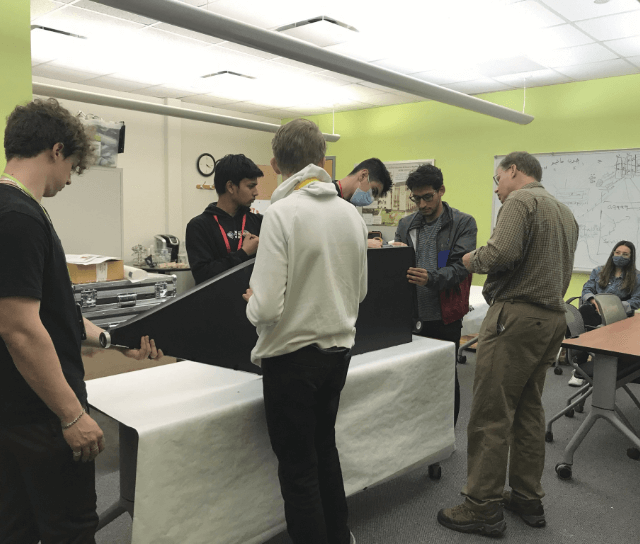Building Detectors
The detector design incorporates a sheet of scintillator material that emits light as high-energy charged particles in a cosmic ray air shower pass through. This light is guided to a photomultiplier, which produces an electric current proportional to the amount of detected light. A custom electronics box transduces these signals to a computer, which is networked with a central database and analysis warehouse. Assembled detectors will be put in weatherproof ski-boxes and mounted on the roof of participating high schools.
Scintillators are used to detect charged particles that are created during collisions of high-energy cosmic rays with our atmosphere. The material of which these detectors are made has the property of generating a flash of light when a charged particle flies through it. The light intensity depends on the amount of energy released by the incoming charged particle in the material. The light pulses are converted into electrical signals by photomultiplier tubes.
The number of particles that pass the detector per unit time is very high. Because we are only interested in the particles that come from the same avalanche (and therefore come from the same incoming cosmic particle), two scintillator plates (each 0.5 m2) with a horizontal distance of a number of meters are used. Particles must pass through both plates simultaneously. Particles from the same avalanche arrive on Earth at almost exactly the same time. By correlating the data from the various measuring stations, particle avalanches can be investigated, which extend over an area of hundreds of square kilometers. Using the particle density and angle of incidence, the energy of the cosmic particle that caused the avalanche can ultimately be determined.
The HiSPARC electronics
The HiSPARC II electronics integrate fast signal processing, conversion of two analog signals from the photomultiplier tubes to digital format, and a precision GPS, in one housing. The electronics sends its data to the PC via a USB connection. Another USB connection is for direct communication between the GPS and a GPS monitoring program on the PC. This allows the GPS settings to be verified and/or adjusted. A program written in LabVIEW runs on the PC, with which the HiSPARC II electronics can be fully controlled. The LabVIEW program is also responsible for collecting and transmitting the measurement data coming from the HiSPARC electronics.
